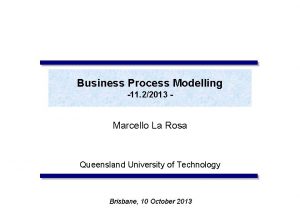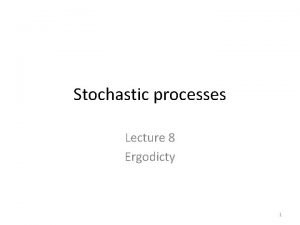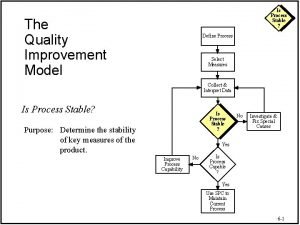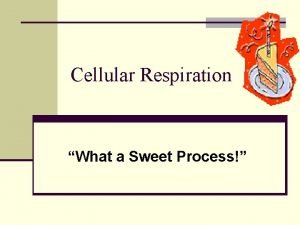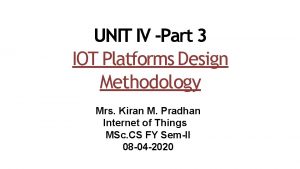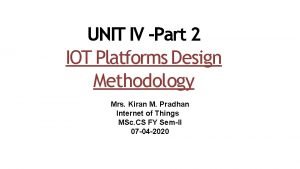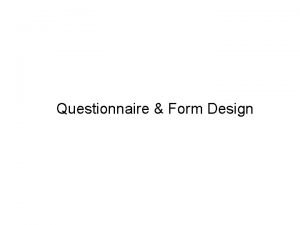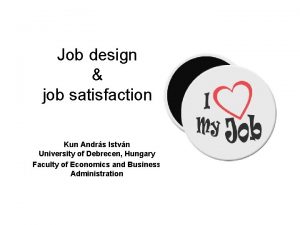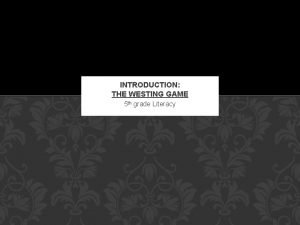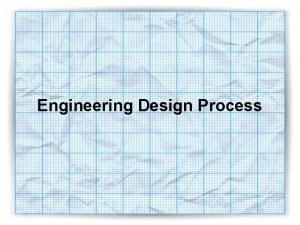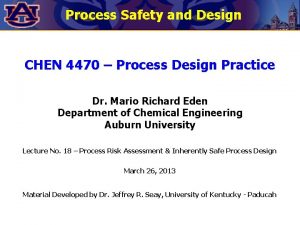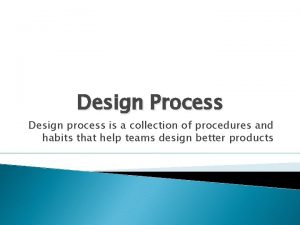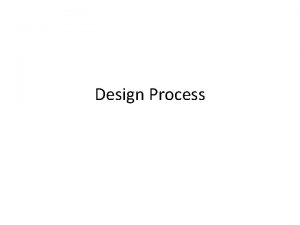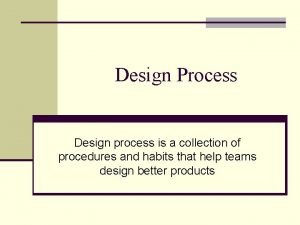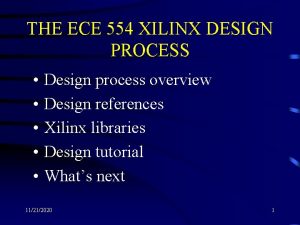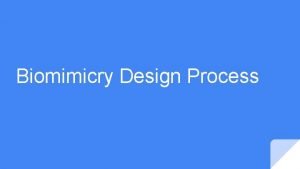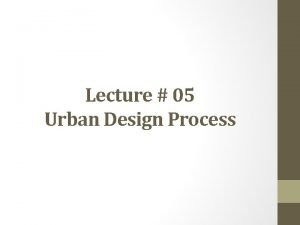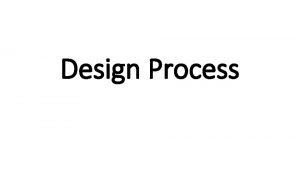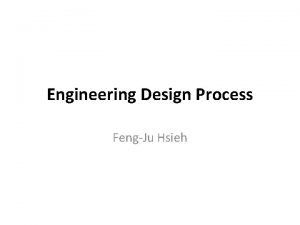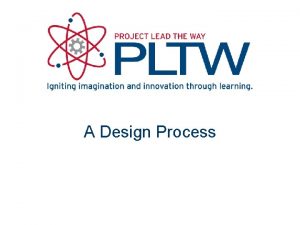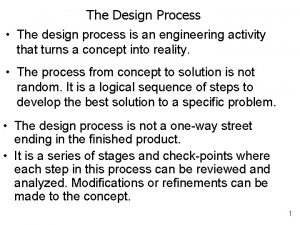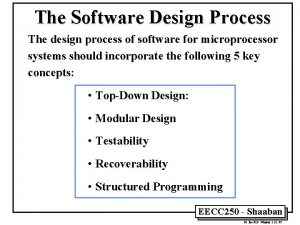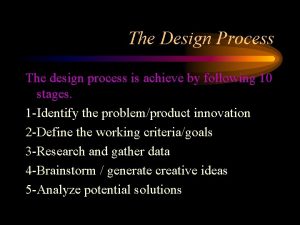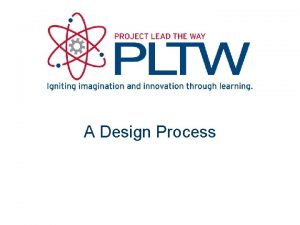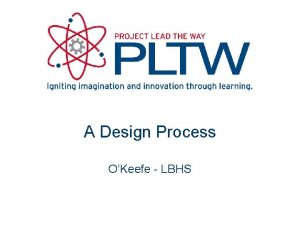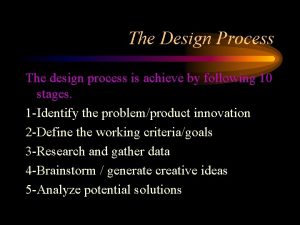Design Process What is Design Design is a























- Slides: 23

Design Process

What is Design? • Design is a creative planning process that leads to useful products and systems. • There is no perfect design. • Requirements of a design are made up of criteria and constraints.

What is the Design Process? • The design process is a purposeful method of planning practical solutions to problems. • The design process is never final; there always multiple solutions to a problem. • The design process is influenced by requirements called criteria and constraints.

CRITERIA • cri·te·ri·on (kr-tîr-n) n. pl. cri·te·ri·a (-tîr) or cri·te·ri·ons A standard, rule, or test on which a judgment or decision can be based. See Synonyms at standard. • con·straint (kn-strnt) n. • 1. One that restricts, limits, or regulates; a check:

Adopted PLTW® High School Design Process

Adopted GTT Design Process 11 10 9 Communicate Results Create or Make Refine 8 7 11 Define the Problem Test and Evaluate Design Process 3 Research and Generate Ideas 3 4 4 6 5 5 6 7 Research Develop Ideas Model or Prototype The adopted GTT design process combines several steps. 2 Brainstorm Improve Design Choose Best Idea Develop a Design Proposal Identifying Criteria and Constraints Explore Possibilities Select an Approach

9 Communicate Results 1 Define the Problem 2 8 Brainstorm Improve Design Process 7 Test and Evaluate 6 Model or Prototype 5 Choose Best Idea 3 Research 4 Develop Ideas Define the Problem Defining the problem is like conducting detective work. You must examine the evidence and form some conclusions. Examples: Design a vehicle that can communicate with other vehicles to prevent accidents. Design an athletic shoe that decreases the amount of sprained ankles when worn on hardwood gym floors.

9 Communicate Results 1 Define the Problem 2 8 Brainstorm Improve Design Process 7 Test and Evaluate 6 Model or Prototype 5 3 Research 4 Develop Ideas Choose Best Idea Brainstorming involves bringing a group of people together to generate many different ideas. Examples: “Make the athletic shoe out of plastic. ” “The shoe needs to grip the floor; the bottom should be made of rubber. ” “The ankle support should be stiff. ” “Don’t forget the air vents. ” All ideas are considered – none are criticized!

9 Communicate Results 1 2 8 Research Define the Problem Brainstorm Improve Design Process 7 Test and Evaluate 6 Model or Prototype 5 Choose Best Idea 3 Research 4 Develop Ideas Research may require going to the library, using computer databases, writing letters, performing experiments, and asking questions. Examples: ü Read books and magazines ü View films or videos ü Search the Internet ü Ask questions of the “experts” ü Create and analyze a survey

9 Communicate Results 1 Define the Problem 2 8 Brainstorm Improve Design Process 7 Test and Evaluate 6 Model or Prototype 5 Choose Best Idea 3 Research 4 Develop Ideas Develop multiple ideas that will solve the problem and meet the requirements. The alternatives may all be quite diverse. Criteria: ü How will the solution actually work? ü What materials should I use? ü What should the product look like so that people will buy it? Constraints: ü Will it be completed by the deadline? ü What size should it be?

9 Communicate Results 1 Define the Problem 2 8 Brainstorm Improve Design Process 7 Test and Evaluate 6 Model or Prototype 5 Choose Best Idea 3 Research 4 Develop Ideas Choose Best Idea Decide on an idea that best meets the criteria, fits within the constraints, and has the least amount of negative characteristics. List the strengths and weaknesses of each alternative. Optimization – Making improvements to the design idea for better performance or increased safety Trade-off – Giving up one desirable trait for another (i. e. , giving up on using a certain material so that the object is more affordable)


9 Communicate Results 1 Define the Problem 2 8 Brainstorm Improve Design Process 7 Test and Evaluate 6 Model or Prototype 5 Choose Best Idea 3 Research 4 Develop Ideas Model or Prototype Model building is used to gather additional information and test design ideas. Construct. Examples: Realistic drawings or renderings help you visualize what the solution will look like in real life. Scale models or mock-ups are small, accurate representations of the final product. 3 D CAD (computer aided designs) can show objects in action. A prototype is a working model; it looks and functions just like the finished product.

9 Communicate Results 1 Define the Problem 2 8 Brainstorm Improve Design Process 7 Test and Evaluate 6 Model or Prototype 5 Choose Best Idea 3 Research 4 Develop Ideas Test and Evaluate Test your solution, answer important questions. We need to see how well our solution works. Is it safe for people and the environment? Is it comfortable? Is it affordable? Is it aesthetically pleasing (does it look good)? Will it last as long as it needs to? Does it meet the criteria and constraints? Does it work?

9 Communicate Results 1 Define the Problem 2 8 Brainstorm Improve Design Process 7 Test and Evaluate 6 Model or Prototype 5 Choose Best Idea 3 Research 4 Develop Ideas Improve Design After studying all test data and evaluating design solutions, you may need to make changes. Now is the time to improve a design – before production begins. During the improve design phase, you may consider new ideas. 100 X 6, 000=600, 000

9 Communicate Results 1 Define the Problem 2 8 Brainstorm Improve Design Process 7 Test and Evaluate 6 Model or Prototype 5 Choose Best Idea 3 Research 4 Develop Ideas Communicate Results Share your design ideas with others to prove the design is worthy of manufacturing. Examples: Poster Drawings Charts Prototypes Power. Point presentation Reports Discussion

Adopted GTT Design Process 11 10 9 Communicate Results Create or Make Refine 8 7 11 Define the Problem Test and Evaluate Design Process 3 Research and Generate Ideas 3 4 4 6 5 5 6 7 Research Develop Ideas Model or Prototype The adopted GTT design process combines several steps. 2 Brainstorm Improve Design Choose Best Idea Develop a Design Proposal Identifying Criteria and Constraints Explore Possibilities Select an Approach

DESIGN SQUAD http: //pbskids. org/designsquad/video/ds-unplugged/

Desigin Process Activity • Problem – Society needs a wearable emergency medical identification device for children. • Conclusion – Design a band that can be worn on a finger or necklace

Criteria and Constraints • The device must be worn on a finger or neckalce • The device must display at least 1 identifying number or letter. • The device can not display more than 2 identifying numbers or letters. • The device must be removable. • The device can be no taller than 10 mm • The device must have a diameter smaller than 30 mm.

Design Process Chart • Problem Identification: write down what our probem was • Brainstorm: write down any ideas including pictures of what you want your solution to look like • Develop Ideas: Narrow down your information into 2 -3 workable solutions, remember it must meet the criteria and contraints. • Choose Idea: write down why you chose your idea, why will it solve the problem the best. • Model and Prototype: write down the steps you used to create the device in the CAD program

Your Task • Using your design process chart, record your steps as you solve the problem. • You will fill in your actions for each step until you come to the model and prototype section (this is where we build, CAD) After building you will record any improvements needed and the process you will use to communicate your solution.

Image Resources Microsoft, Inc. (2008). Clip Art. Retrieved September 25, 2008, from http: //office. microsoft. com/en-us/clipart/default. aspx Wikimedia commons (2008). Retrieved September 25, 2008, from http: //commons. wikimedia. org/wiki/Image: Dummies. jpg
 Split range
Split range Olecranon process vs fossa
Olecranon process vs fossa Substantive vs procedural due process
Substantive vs procedural due process Business process levels
Business process levels Ergodicity
Ergodicity What is process to process delivery
What is process to process delivery Condylar and coronoid process of mandible
Condylar and coronoid process of mandible Stable quality
Stable quality Process-to-process delivery
Process-to-process delivery Sweet process
Sweet process Process street vs sweet process
Process street vs sweet process Engineering design process quiz answers
Engineering design process quiz answers Vce visual communication tutors
Vce visual communication tutors Embedded iot platform design methodology
Embedded iot platform design methodology Iot system design methodology
Iot system design methodology Technological design definition
Technological design definition Service design process example
Service design process example Research questionnaire
Research questionnaire Aerospace design process
Aerospace design process Basic engineering design process
Basic engineering design process Job design and job satisfaction
Job design and job satisfaction The westing game anticipation guide
The westing game anticipation guide Stanford design thinking process
Stanford design thinking process Food product development process steps
Food product development process steps



